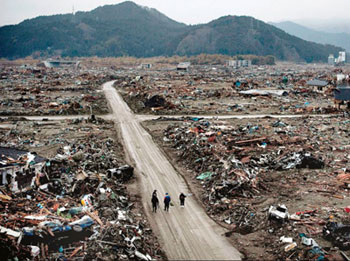(lead article, commentary)
Fukushima 1 year later:
nuke panic vs. real disaster

|
|
Town of Rikuzentakata, Japan, after March 2011 tsunami. Nearly 20,000 people were killed in total, none from near meltdown of nuclear plant in Fukushima. Deaths were result of economic and social relations of capitalism, which puts profits above human needs.
|
BY LOUIS MARTIN
This month marks the one-year anniversary of the so-called nuclear disaster in Fukushima, Japan, which touched off an international hue and cry from opponents of nuclear power that has overshadowed the real colossal social disaster wrought by capitalism.
Some 20,000 people were killed and tens of thousands more injured in the wake of a massive tsunami triggered by a 9.0 earthquake. The figure is staggering, more than 12 times the number killed in the capitalist-made disaster that followed Hurricane Katrina. Entire coastal villages and towns were wiped out or severely damaged.
The earthquake knocked the Fukushima Daiichi Nuclear Power Station off the power grid, halting the cooling system for fuel rods. The tsunami then destroyed the plant’s backup generator, causing three of six reactors to overheat and release radioactivity in the atmosphere and the ocean.
The near meltdown revealed how the Tokyo Electric Power Company, with the blessing of four government administrations, disregarded the most elementary precautions in its drive for profit.
The basic facts today are well known. The plant used a cheaper containment vessel for fuel rods prone to rupture in the event of a cooling system failure. Tepco’s owners never adequately raised the elevation of the backup generator, despite the potential for tsunamis in the area. Company officials deliberately delayed action to cool down the reactors in order to protect their investment. Surely, if private profit didn’t drive the reactor’s operation, the entire incident would have been avoided.
But we see this approach everyday in every part of the world where capitalist social relations dominate production. It flows from the way the capitalist system always has and always will function: to maximize profits while simultaneously undermining the source of all wealth, the earth and the worker.
Despite all this, zero is the number of people who have reportedly died as a result of nuclear radiation poisoning related to the Fukushima plant. Another striking figure, given the combination of the bosses’ recklessness and the destructive power of earthquakes and tsunamis. The basic facts about what is considered the second worst nuclear disaster in world history actually provides a very strong argument against the assertion that nuclear power presents a special inherent danger to humanity.
The so-called environmentalist opposition to nuclear power—or other forms of energy—is anti-scientific and reactionary. The various “green” forces and their nostrums provide no earthly option for maintaining modern civilization, let alone for advancing industrial development. They stand in opposition to the development of semicolonial nations oppressed by imperialism and are antagonistic to the needs of the great majority of humanity.
In contrast, the communist movement champions the expansion and extension of electrification and industrialization worldwide, and along with it growth of the proletariat and culture. This is essential for closing the gap between the imperialists and semicolonial world and bringing the world’s toilers closer together in common struggle.
A capitalist-made catastrophe
On the other hand, the deaths of 20,000 people cannot be chalked up to an avoidable natural disaster.
Social relations under capitalism, not nature, determined that hundreds of thousands of people—workers, farmers, fishermen and small business owners—would inhabit low-lying, tsunami-prone coastal areas. The Japanese capitalist rulers, like their counterparts worldwide, have no financial interest in providing housing and transportation on better-protected higher grounds—the very locations where they and well-to-do middle-class layers and professionals can afford to live.
Japan sits on volatile tectonic plates. The government there had not instituted a sufficient tsunami warning system, despite the fact that more than six years earlier a massive earthquake and tsunami in the Indian Ocean killed more than 225,000 people—mostly in Indonesia, Sri Lanka, India and Thailand.
The Japan Meteorological Agency erroneously projected that day that a 10-foot plus tsunami would hit northeastern Japan.
Concrete walls line about 40 percent of Japan’s coastline, many places 33 feet high. But in the region hit by the tsunami, the walls were about 10 feet high. The waves turned out to be 40 feet high on average. The whole warning and protection system had been built for a lesser case—and cost-saving—scenario.
While not one person has reportedly died from the nuclear leak, people did die as a result of the anti-nuclear hysteria promoted by the government. According to recent coverage of the events by the New York Times, an unknown number of tsunami survivors—people trapped in the rubble, sick people, elderly and others unable to leave on their own—“probably starved to death” as the government ordered rescuers to evacuate the area for weeks “for fear of radiation.”
The dislocation is ongoing. One year after the disaster, hundreds of thousands of working people still live in shelters and lack employment.
Example of the Cuban Revolution
This contrasts sharply with Cuba, where workers and farmers got rid of capitalist social relations of property through a powerful revolution and have since used their government to meet human needs, not private profits.
Cuba has been hit by a series of powerful hurricanes in recent years that have killed thousands of people in the Caribbean and southern United States. But only 30 people have died in 16 major hurricanes there over the last decade. Prevention and evacuation are organized as a social undertaking, on the basis of working-class solidarity from the neighborhood and town to national level.
Related articles:
Fidel Castro on defense of Iran’s right to nuclear power
‘Cuba never considered, doesn’t need nuclear weapons’
| 


